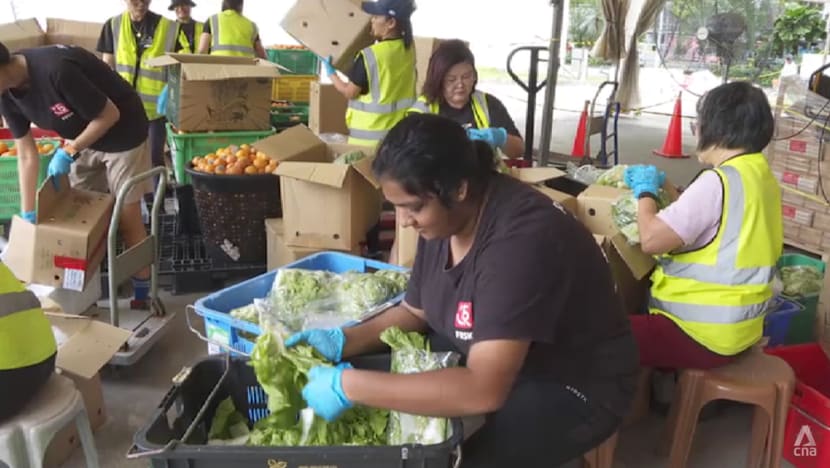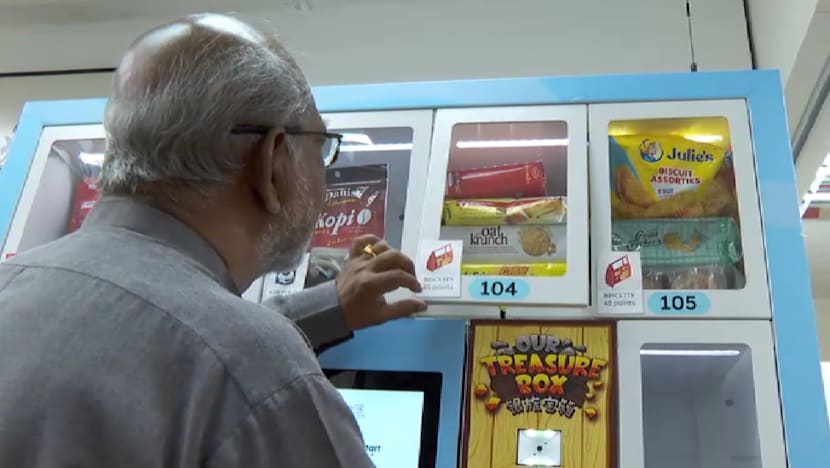Charities call for more nutritious food donations as demand among seniors increases
Some social service agencies are seeing up to 15 per cent more elderly relying on food assistance compared with last year.

Charity personnel sort fresh produce. Non-profit organisations say there are not enough donations of fresh fruits and vegetables to meet demand.

This audio is generated by an AI tool.
SINGAPORE: Non-perishable staples such as rice and canned food remain the most commonly donated food items in Singapore as they are easy to store, transport and distribute.
Non-profit organisations say that while these donations are practical, they often lack essential nutrients – particularly those found in fresh fruits and vegetables. Many donated items are high in sodium and sugar, but low in protein and fibre.
This nutritional gap is becoming more concerning as the number of seniors depending on food donations continues to rise.
Seniors relying on food aid told CNA they usually have to get fresh produce on their own at grocery stores.
EFFORTS TO IMPROVE NUTRITION
Food Rescue Sengkang is among the community organisations working to address this nutrient shortfall by focusing on the redistribution of fresh produce.
“We noticed that other charities tend to give out only dry rations. We need fruits and vegetables to have a balance,” said the group’s founder Derek Ong.
“(Beneficiaries) can't go on dry rations forever. We noticed people are not having a balanced diet … that's why we fill the gap.”
The ground-up initiative aims to curb food waste by collecting surplus, unsold or rejected food from businesses and redistributing them to charities and community groups.
Often, such items are turned away by restaurants or supermarkets due to cosmetic imperfections or approaching "best-before" dates, even though they are still safe to consume.
Last year, the organisation recovered about 956 tonnes of food, of which 520 tonnes – more than half – were fresh fruits and vegetables. The rest included bread, frozen fruits and non-perishables like noodles and oatmeal.
Mr Ong said the key in fresh food rescue lies in identifying those that still retain nutritional value.
“People are more willing to accept rescue food now because of (more) education. These (so-called) ugly foods don't lack nutritional value compared to those that look nice,” he told CNA.
TACKLING FOOD WASTE
A key challenge in redistributing surplus food is its short shelf life, which is further shortened by Singapore’s hot and humid climate.
“Trying to get food … from the F&B providers to the individual households is also very difficult. The cost of logistics isn't cheap … there’s also the issue of timing,” said Mr Arthur Chin, executive director of The Food Bank Singapore.
Cooked food, for instance, must be consumed within four hours of preparation under food safety guidelines.
The non-profit collects and redistributes donated food to households, aiming to reduce waste and strengthen food security. Last year, it redistributed 612 tonnes of food.
Singapore generates about 750,000 tonnes of food waste each year, making up roughly 11 per cent of the nation’s total waste.
Mr Chin said tackling food waste requires not only better logistics and redistribution networks, but also a shift in public mindset.
“The reality is we need to shift the mindsets of the next generation of Singaporeans towards food wastage,” he told CNA938.
“We ensure that we slowly work towards reducing the (amount) of food that unfortunately goes to the landfills, so that everyone – from seniors to working families and students – get access to nutritional food.”
CHALLENGES IN FOOD RESCUE
Another challenge is in handling and sorting donated produce.
Lions Befrienders, which provides care and support to seniors, said it can be difficult to reallocate fresh food donations quickly enough before they spoil.
“The question is, how fast can we distribute the moment it arrives? What condition does it arrive in? How fast is (our) turn around?” said Ms Karen Wee, the charity’s executive director.
“The problem comes with the manual labour in sorting out what's usable and what's not usable. A lot of time is spent sorting the vegetables.”
She added that the nutritional value of donated food is especially important given the rising number of seniors seeking help.

Lions Befrienders has seen up to 15 per cent more elderly now relying on food assistance compared with last year. Many live alone, face mobility challenges or are under financial strain.
“It's always the sandwich classes that have difficulties. (With) their incomes stopped since they retired ... we see an increase (in the number) of them asking for more help,” she said.
To make food assistance more accessible, the charity recently introduced Our Treasure Box, a smart locker system that allows seniors to collect food rations or care packs at any time.
The initiative also encourages seniors to take charge of their health. By monitoring indicators such as body mass index (BMI), they can earn points that can be redeemed for essential items and treats.
The organisation said this encourages regular health checks and promotes a proactive approach to wellness.
“(The seniors) are able to make discerning choices because now we put healthy and healthier choices inside (the packs). With that, we are also trying to educate the public that this is the direction to go,” Ms Wee added.














